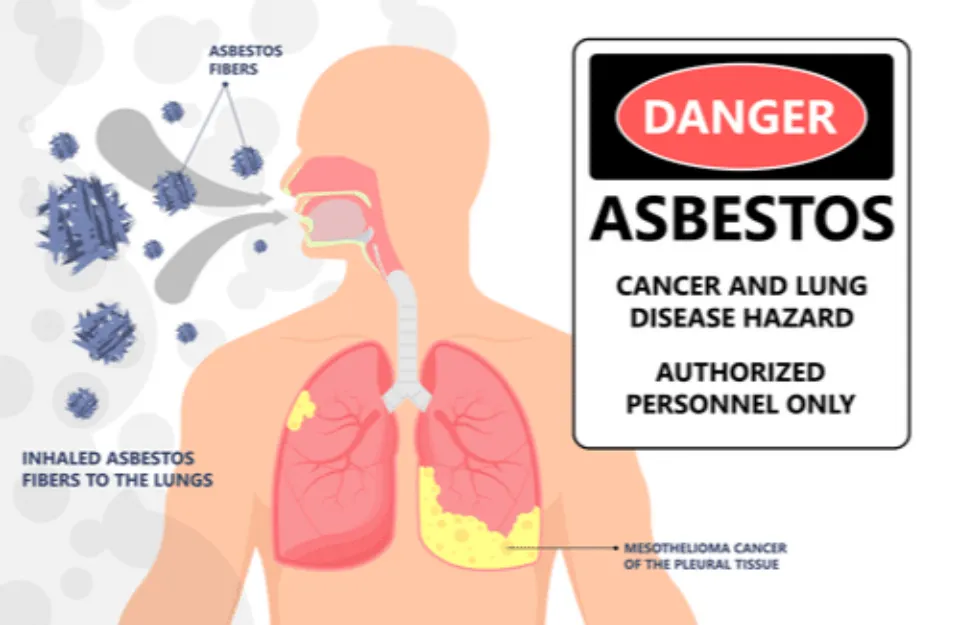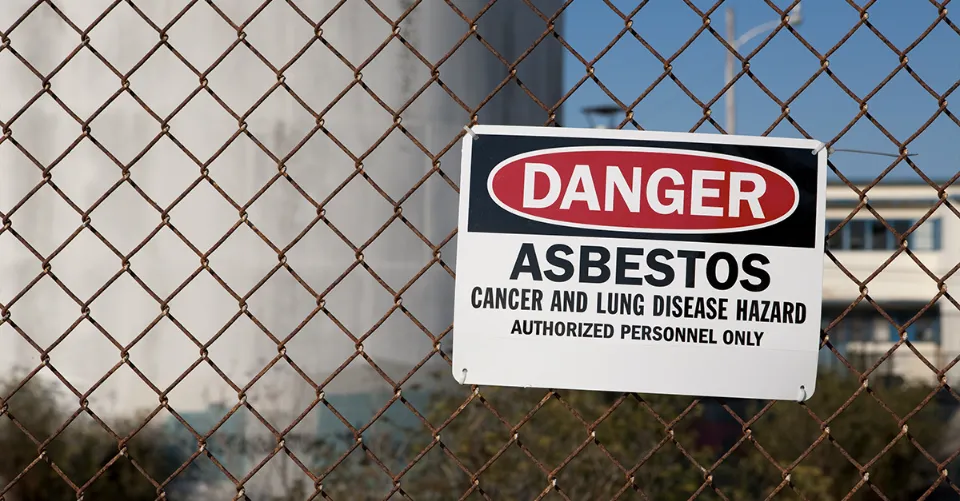The probability of developing an asbestos-related disease depends on the level of asbestos exposure, such as a single exposure or repeated cumulative exposure. Each year, thousands of Americans die from illnesses related to asbestos. Nearly 40,000 Americans have died as a result of previous asbestos exposure. deaths in 2016 alone, according to the World Commission on Occupational Health.
It is prudent to be aware of the risks associated with asbestos exposure, and it is reasonable to be concerned if you find out you have been exposed to the substance. Different levels of asbestos exposure must be distinguished, though, for safety reasons.
Asbestos Exposure and Cancer Risk
- Light, short-term exposure rarely causes disease
- A one-off exposure from do-it-yourself renovation is not a major risk
- Asbestos exposure is cumulative, so short-term exposures can add up
- Disasters may cause extreme asbestos-exposure events
Although asbestos has a reputation for being deadly, many people have a hazy understanding of why the toxic mineral is risky.

Some people might believe that asbestos is a substance that, like some pesticides, can build up in the food chain or be absorbed through the skin. As if asbestos were radioactive, some people may even worry that they will become ill just from being close to a product that contains asbestos.
Thankfully, neither of these statements is accurate. In reality, asbestos dust inhalation or ingestion can result in dangerous asbestos exposure.
When asbestos-related diseases manifest, it’s typically because millions of tiny mineral fibers have gathered in a person’s body’s membrane lining or lung tissue.
Is Short-term Exposure Harmful?
A single asbestos exposure can result in the development of a disease like asbestosis, mesothelioma, pleural effusions, or lung cancer if the exposure was severe enough to cause asbestos fibers to lodge in the body’s tissues. One well-known instance is the 9/11 attack.
Over 400 tons of toxic materials, including asbestos, were released into the air over New York City as a result of the collapse of the Twin Towers. It’s possible that the survivors, first responders, and locals at the time inhaled enough asbestos during this singular incident to cause later health issues.
The average person will not experience long-lasting health issues as a result of a single exposure to asbestos, though. It’s possible that a single exposure to a small amount of asbestos won’t cause the victim to swallow or inhale enough dust to cause health problems.
Usually, it takes millions of microscopic asbestos fibers to build up in a person’s lungs before the tissues are damaged and diseases result. Therefore, those who regularly worked with or around asbestos are most at risk.
Types of Cancer Caused by Asbestos
Multiple cancers, most notably mesothelioma, have been linked to asbestos. In every case of cancer linked to asbestos exposure, a person’s risk of developing the disease is higher the more asbestos exposure they had.
Mesothelioma
The only known factor that causes mesothelioma is exposure to asbestos. It may take 10 to 50 years for symptoms to appear after asbestos has caused this cancer.
In the United States, malignant mesothelioma affects about 3,000 people annually.
There are 4 types of mesothelioma:
- Pleural Mesothelioma: The mesothelium’s pleura, which serves as the lining of the lungs, is where this particular type of mesothelioma develops. Pleural mesothelioma accounts for about 80% of cases of mesothelioma.
- Peritoneal Mesothelioma: This type of cancer targets nearby organs and the lining of the abdomen. Peritoneal mesothelioma can affect the stomach, liver, or spleen. Approximately 20% of cases of mesothelioma are of this type.
- Pericardial Mesothelioma: In this kind, the pericardium, the lining of the heart, becomes infected with asbestos fibers. Pericardial mesothelioma makes up about 1% of all cases and is frequently misdiagnosed as another cardiac disorder.
- Testicular Mesothelioma: This extremely rare form of mesothelioma grows in the tunica vaginalis, which lines the testes. In the literature, there are fewer than 300 confirmed cases of testicular mesothelioma.
Although there are treatments for all types of mesothelioma, the outlook for recovery and life expectancy is frequently poor.
Additionally, the businesses that put millions of Americans at risk of contracting this terrible disease by exposing them to asbestos were compelled to set up asbestos trust funds in order to compensate their victims.
Lung Cancer
By swallowing or inhaling asbestos fibers, asbestos-related lung cancer is brought on. Unlike pleural mesothelioma, which develops in the lining of the lung, asbestos lung cancer begins to manifest itself within the lungs.
Workers might have inhaled asbestos fibers during:
- Asbestos mining
- The breaking down of asbestos products, which disturbs the fibers and releases them into the air
- The manufacturing of asbestos-containing products
20% of tumors located in the lungs are linked to asbestos exposure.
Asbestos exposure can lead to lung cancer in a two-part process:
- In the lungs’ delicate inner tissues, asbestos fibers ensnare themselves.
- Throughout the soft tissue and into the lining of the lung, asbestos fibers move.
Since there is no way to force these fibers out of the lungs once they are there, they begin to rip small slits in the lung tissue. The body will attempt to cover these tiny incisions with scar tissue as part of its natural response to start the healing process.
Tumors can develop as a result of small or large buildups over time. The tumors may develop into malignant forms in some cases, which means they have the potential to grow. After asbestos exposure, lung cancer may not manifest for 10–50 years, similar to mesothelioma cases.
The risk of lung cancer linked to asbestos can significantly increase in people who smoke tobacco products. Smokers are up to 50 times more likely than non-smokers to develop cancer linked to asbestos exposure.
Other Cancers Linked to Asbestos
Numerous other cancers, besides mesothelioma, can be brought on by asbestos.
Other asbestos-related cancers include:
- Cancers found in other abdominal organs
- Colorectal cancer
- Laryngeal (voice box) cancer
- Ovarian cancer
- Pharyngeal (throat) cancer
- Stomach cancer
How Much Exposure to Asbestos Causes Cancer?
People should always take precautions to avoid inhaling toxic dust because there is no level of asbestos exposure that is considered safe.
Most illnesses connected to asbestos, though, don’t manifest until years of repeated exposure. Additionally, a brief, extremely intense exposure raises the danger of developing a disease later in life.
For instance, working with insulation products in the 1950s or 1960s is a significant risk factor today. A few months of this would result in a lot of asbestos dust being inhaled, even if the work only required small amounts of exposure at a time.

The majority of asbestos cancer and asbestosis cases can be linked to this particular form of occupational asbestos exposure.
Asbestos dust that workers brought home on their clothing exposed family members on a regular basis. Secondhand asbestos exposure is what this is, and it has also been connected to a lot of tragic deaths.
These kinds of long-term exposure decreased in prevalence in America after asbestos was regulated in the 1970s and 1980s. But because the onset of asbestos-related diseases typically takes decades, there will likely always be new cases because of widespread asbestos exposure from decades ago.
Additionally, a significant amount of asbestos exposure could be brought on by a single incident.
An enormous cloud of toxic dust, for instance, was produced when the twin towers were destroyed on September 11, 2001. Residents and rescue personnel exposed to it are more likely to get cancer.
Risk Factors for Asbestos-Related Diseases
The likelihood that asbestos exposure will make someone ill depends on a number of risk factors.
- Dose of Asbestos: The worst exposure occurs when visible clouds of raw asbestos fibers are present in the air.
- Duration of Exposure: One of the biggest risk factors is spending months or years working or living in a contaminated environment.
- Type of Asbestos: Chrysotile, the common white asbestos, is known to be harmful, but it is believed that the other types of asbestos are even more harmful.
- Genetics: Not everyone who has had prolonged exposure to asbestos experiences a related illness. Researchers think specific genetic mutations might also be involved.
- Smoking History: The combined effects of asbestos and cigarette smoke increase a person’s risk of developing lung cancer.
Final Thoughts
Depending on the type of asbestos-related illness or cancer a person has been diagnosed with, there are various treatment options available. Notably, the type of mesothelioma a patient has determines the different treatments available. These therapies seek to relieve patients’ symptoms and, in some cases, even extend their lives. Chemotherapy, radiation therapy, and surgery are the most frequently used treatments for mesothelioma.
FAQs
How Long After Exposure to Asbestos Do Symptoms Appear?
Diseases linked to asbestos exposure typically take at least 20 years to manifest after exposure. The early signs of a disease can resemble those of a cold. However, symptoms of a disease develop gradually.
Can Short-term Asbestos Exposure Cause Mesothelioma?
Mesothelioma and other types of cancer can result from brief exposure to asbestos dust. However, the chance of developing cancer from brief exposure is extremely low unless the exposure is intense.



